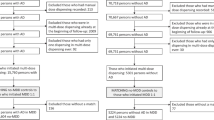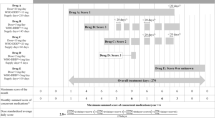Abstract
Aim
Atropinic drugs in patients with Alzheimer disease (AD) can decrease the effects of anticholinesterase drugs and/or induce adverse drug reactions (ADRs). Several atropinic risk scales defining an atropinic burden of drugs were proposed but were little used in AD patients.
Methods
All ADRs’ notifications of AD patients registered in the Midi-Pyrénées PharmacoVigilance Database between 1999 and 2013 were analyzed using Anticholinergic Drug Scale (ADS) and Anticholinergic Duran’s list. The primary objective was to quantify atropinic burden in AD patients and the secondary one to investigate associated factors.
Results
Among the 475 notifications, at least one atropinic drug was found in 282 notifications (59.4 %) according to ADS and 214 (45.1 %) according to Duran. Mean number of atropinics per notifications was 0.9 ± 0.9 (ADS) and 0.7 ± 0.9 (Duran). Mean atropinic burden per notifications was 1.2 ± 1.5 (ADS) and 0.9 ± 1.3 (Duran). Atropinic burden ≥ 3 was found in 87 notifications (18.2 %) according to ADS and 50 (10.5 %) according to Duran. There was no association between atropinic burden and age of patients. The number of drugs is associated to a high atropinic burden.
Conclusion
The present work found an association between an atropinic drug and an anticholinesterase agent in around 1 out of 2 AD patients and a clinically significant atropinic burden (≥3) in around 1 to 2 AD patients out of 10. The benefit harm balance of atropinic drugs must be discussed before each prescription in AD patients.
Similar content being viewed by others
References
Selkoe DJ, Schenk D (2003) Alzheimer’s disease: molecular understanding predicts amyloid-based therapeutics. Annu Rev Pharmacol Toxicol 43:545–584
Perry EK (1986) The cholinergic hypothesis-ten years on. Br Med Bull 42:63–69
Sellal F, Nieoullon A, Michel G, Michel BF, Lacomblez L, Geerts H, Delini-Stula A, Bentué-Ferrer D, Bordet R, Allain H (2005) Pharmacology of Alzheimer’s disease: where do we go from here? Therapie 60:89–107
Forette F, Hauw JJ (2010) Treatment of Alzheimer’s disease and future approaches. Therapie 65:429–437
Montastruc JL, Durrieu G, Damase-Michel C, Lapeyre-Mestre M (2010) Anticholinergics, antimuscarinics or atropinics? Atropinic burdenout the words in pharmacology. Br J Clin Pharmacol 69:561–562
López-Álvarez J, Zea Sevilla MA, Agüera Ortiz L, Fernández Blázquez MA, Valentí Soler M, Martínez-Martín P (2015) Effect of anticholinergic drugs on cognitive impairment in the elderly. Rev Psiquiatr Salud Ment 8:35–43
Durán CE, Azermai M, Vander Stichele RH (2013) Systematic review of anticholinergic risk scales in older adults. Eur J Clin Pharmacol 69:1485–1496
Montastruc F, Retailleau E, Rousseau V, Bagheri H, Montastruc JL (2014) Atropinic burden of prescription forms in France: a study in community pharmacies in 2013. Eur J Clin Pharmacol 70:1147–1148
Montastruc JL, Sommet A, Lacroix I, Olivier P, Durrieu G, Damase-Michel C, Lapeyre-Mestre M, Bagheri H (2006) Pharmacovigilance for evaluating adverse drug reactions: value, organization, and methods. Joint Bone Spine 73:629–632
Edwards IR, Aronson JK (2000) Adverse drug reactions: definitions, diagnosis, and management. Lancet 356:1255–1259
Carnahan RM, Lund BC, Perry PJ, Pollock BG, Culp KR (2006) The Anticholinergic Drug Scale as a measure of drug-related anticholinergic burden: associations with serum anticholinergic activity. J Clin Pharmacol 46:1481–1486
Fox C, Richardson K, Maidment ID, Savva GM, Matthews FE, Smithard D, Coulton S, Katona C, Boustani MA, Brayne C (2011) Anticholinergic medication use and cognitive impairment in the older population: the medical research council cognitive function and ageing study. J Am Geriatr Soc 59:1477–1483
Lu CJ, Tune LE (2003) Chronic exposure to anticholinergic medications adversely affects the course of Alzheimer disease. Am J Geriatr Psychiatry 11:458–461
Tavassoli N, Sommet A, Lapeyre-Mestre M, Bagheri H, Montastruc JL (2007) Drug interactions with cholinesterase inhibitors: an analysis of the French pharmacovigilance datatropinic burdenase and a comparison of two national drug formularies (Vidal, British National Formulary). Drug Saf 30:1063–1071
Montastruc F, Gardette V, Cantet C, Piau A, Lapeyre-Mestre M, Vellas B, Montastruc JL, Andrieu S, REAL.FR Group (2013) Potentially inappropriate medication use among patients with Alzheimer disease in the REAL.FR cohort: be aware of atropinic and benzodiazepine drugs! Eur J Clin Pharmacol 69:1589–1597
Sura SD, Carnahan RM, Chen H, Aparasu RR (2013) Prevalence and determinants of anticholinergic medication use in elderly dementia patients. Drugs Aging 30:837–844
Moulis F, Moulis G, Balardy L, Gérard S, Montastruc F, Sourdet S, Rougé-Bugat ME, Lapeyre-Mestre M, Montastruc JL, Rolland Y, Vellas B (2014) Exposure to atropinic drugs and frailty status. J Am Med Dir Assoc. doi:10.1016/j.jamda.2014.11.017
Torvinen-Kiiskinen S, Taipale H, Tanskanen A, Tiihonen J, Hartikainen S (2014) Concomitant use of acetylcholine esterase inhibitors and urinary antispasmodics among Finnish community-dwelling persons with Alzheimer disease. J Clin Psychopharmacol 34:722–727
Fox C, Livingston G, Maidment ID, Coulton S, Smithard DG, Boustani M, Katona C (2011) The impact of anticholinergic burden in Alzheimer’s dementia-the LASER-AD study. Age Ageing 40:730–735
Lertxundi U, Domingo-Echaburu S, Hernandez R, Peral J, Medrano J (2013) Expert-based drug lists to measure anticholinergic burden: similar names, different results. Psychogeriatrics 13:17–24
Hazell L, Shakir SA (2006) Under-reporting of adverse drug reactions: a systematic review. Drug Saf 29:385–396
Moore N, Noblet C, Kreft-Jais C, Lagier G, Ollagnier M, Imbs JL (1995) French PharmacoVigilance Datatropinic burdenase system: examples of utilization. Therapie 50:557–562
Montastruc F, Sommet A, Bondon-Guitton E, Durrieu G, Bui E, Bagheri H, Lapeyre-Mestre M, Schmitt L, Montastruc JL (2012) The importance of drug-drug interactions as a cause of adverse drug reactions: a pharmacovigilance study of serotoninergic reuptake inhibitors in France. Eur J Clin Pharmacol 68:767–775
Danton AC, Montastruc F, Sommet A, Durrieu G, Bagheri H, Bondon-Guitton E, Lapeyre-Mestre M, Montastruc JL (2013) Importance of cytochrome P450 (CYP450) in adverse drug reactions due to drug-drug interactions: a PharmacoVigilance study in France. Eur J Clin Pharmacol 69:885–888
Torjesen I (2011) Anticholinergic effects of common drugs are associated with increased mortality in over 65s. Br Med J 342:d4037
Conflict of interest
The authors declare that they have no competing interests.
Financial support
The work was performed during the university research time of the authors using the database which is available without fees in the department of the authors.
Contributors
François Montastruc designed the study, analyzed the data, and wrote the manuscript. Sarah Rouanet performed the analysis, analyzed the data, prepared the results, and reviewed the manuscript. Virginie Gardette analyzed the data and reviewed, corrected, and approved the manuscript. Vanessa Rousseau performed the statistical analyses, reviewed, corrected, and approved the manuscript. Haleh Bagheri designed the study, analyzed the data, reviewed, corrected, and approved the manuscript. Jean-Louis Montastruc designed the study, analyzed the data, and wrote the manuscript.
Author information
Authors and Affiliations
Corresponding author
Rights and permissions
About this article
Cite this article
Montastruc, F., Rouanet, S., Gardette, V. et al. Atropinic burden of prescriptions forms in patients with Alzheimer disease: a cross-sectional study in a French PharmacoVigilance Database. Eur J Clin Pharmacol 71, 891–895 (2015). https://doi.org/10.1007/s00228-015-1869-0
Received:
Accepted:
Published:
Issue Date:
DOI: https://doi.org/10.1007/s00228-015-1869-0




